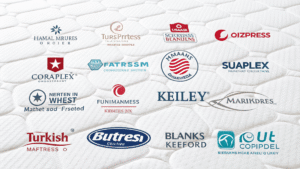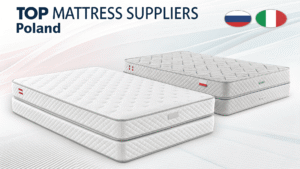Mattress sourcing can feel like a maze — with hidden costs, confusing markups, and risky suppliers.
To find the best wholesale mattress prices, compare manufacturers directly, request bulk discounts, and ask for transparent quotes that include all costs.
If you're sourcing mattresses in volume, keeping your landed cost per container predictable is key. I’ve worked with many furniture retailers and distributors who rely on consistency — not surprises — in pricing and production. As a factory, we’ve seen firsthand how the right strategy unlocks real savings.
What is the average markup on mattresses?
Markup affects your margin more than you think. Miss the numbers, and you lose profit fast.
The average mattress markup ranges from 100% to 150%, but luxury models can go up to 900%.
Understanding mattress markup levels
If a mattress costs a factory $150 to produce, retailers might sell it for $300–$375. That’s typical. But luxury brands often push prices much higher. I’ve seen $250-cost foam mattresses retailing at over $1,800.
| Mattress Type | Avg. Factory Cost | Retail Price | Markup % |
|---|---|---|---|
| Budget Foam | $80 | $160 | 100% |
| Hybrid Mid-Range | $150 | $375 | 150% |
| Organic Latex | $250 | $900 | 260% |
| Designer Luxury | $300 | $2,700 | 800–900% |
This is why understanding markup is crucial if you're sourcing for resale or contract supply.
Can I buy a mattress directly from the manufacturer?
Paying retail price when you’re ordering wholesale? That’s a red flag.
Yes, you can buy directly from mattress manufacturers. Most will offer bulk pricing and customization options.
Why direct-from-factory works
At our factory, we offer direct pricing for distributors and B2B clients. That means no middlemen, better cost control, and faster communication. You also gain access to specification control — foam density, packaging method, brand labeling — all of which are crucial when planning large shipments.
We often help clients customize dimensions, improve container loading efficiency, and even supply marketing images to support online listings. Direct means direct — no guesswork, no retail games.
How do I get the best price on a new mattress?
If you're overpaying, you're not scaling. Timing and strategy change the game.
To get the best price, shop during off-season sales, compare suppliers, and negotiate based on quantity.
Cost-cutting strategies that actually work
You can lower unit costs by:
- Ordering during off-peak months like January or August
- Locking in fixed contracts for 3–6 months
- Using simpler packaging (e.g., roll-pack in polybag instead of designer box)
- Optimizing container loading to avoid unused space
I helped one client reduce their price per unit by over 12% by switching from single-item boxes to dual-load bulk packs. The margin gain was instant.
Can you buy mattresses in bulk?
Whether you’re furnishing dorms or stocking a warehouse, bulk is the only way to make it work.
Yes, buying mattresses in bulk is common. Most factories offer structured discounts starting from 50+ units.
How bulk buying unlocks better value
We typically support full container orders — starting from 180 to 280 pieces per 40HQ depending on mattress thickness and packaging style. The larger your order, the more flexibility you have in:
- Branding
- Packaging format (flat, roll, hybrid)
- Payment terms
- Load optimization
If you're planning recurring orders, we also offer cost protection to avoid pricing swings.
How profitable is selling mattresses?
Margins are real. But only if your backend costs stay lean and predictable.
Selling mattresses is highly profitable due to high markups and low operating costs.
Understanding the profit model
Mattresses are one of the few bulky consumer products with strong margin potential — especially when sold DTC or via your own platform.
| Revenue Channel | Avg. Margin | Notes |
|---|---|---|
| Online DTC | 60–80% | Low cost, high scalability |
| Physical Stores | 50–60% | Higher rent, better upselling |
| Wholesale Supply | 30–45% | Lower margin, higher volume |
We’ve seen clients build entire categories around one or two mattress SKUs — driven by predictable product quality and solid markups.
How to identify trusted wholesale mattress suppliers?
Not all factories are created equal — and many aren’t even factories at all.
To find a trusted supplier, check certifications, reviews, production photos, and ask for samples.
Checklist for verifying a real supplier
As a manufacturer, here’s what we offer upfront:
- Business license, export registration, ISO/FSC documents
- Test certificates (CertiPUR-US, EN597, BS7177 as needed)
- Real-time production photos or walk-through videos
- Free or low-cost samples within 7 days
We also provide production timelines, packaging options, and a full QC report. If your supplier avoids these basics — walk away.
What are the risks of importing mattresses from China?
Importing is profitable — but only if you manage the landmines.
Risks include high U.S. tariffs, foam quality issues, fire safety noncompliance, and delayed shipping.
How to avoid the big risks
We help our clients navigate common issues like:
- Tariff risk: We confirm HS codes and guide U.S. clients on duty classification.
- Foam compression issues: We apply proper curing and packing windows to prevent permanent compression set.
- Labeling compliance: We prepare FR labels and export documentation for each market (US, UK, AU).
Most problems happen when buyers skip compliance. We bake it into our workflow from the start.
What questions should I ask a mattress manufacturer before ordering?
You don’t lose money when you ask too much — only when you assume too much.
Ask about materials, lead time, warranty, fire safety, MOQ, and packaging specs before ordering.
Must-ask questions before confirming
Here’s a list we recommend every buyer send:
- What foam grade do you use? Density? Rebound rate?
- Do your products pass fire safety for my region?
- How long is the production lead time?
- What’s your MOQ for each model?
- Can I get video/photo support for my listings?
- Do you have past client references?
- Are your prices CIF, FOB, or EXW?
We happily answer these — because a clear deal is a good deal.
You thought you were saving money — until the invoice doubled.
To avoid hidden costs, request all-inclusive quotes and clarify logistics, packaging, and certification fees upfront.
How to protect your budget
We always send a breakdown that includes:
- Product unit cost
- Packaging cost (roll/box/flat pack)
- Export cartons or labels
- Local port charges (for FOB)
- CIF charges (if needed)
- Optional test report fees
Buyers who don’t request full quotes often find surprise charges in logistics, palletization, or rework. We keep it clear from the first offer.
What certifications should a mattress supplier have?
Certifications aren’t just paper — they’re your insurance policy.
Key certifications include CertiPUR-US, GOTS, OEKO-TEX, and GREENGUARD for safety and material compliance.
Essential mattress certifications
| Certification | What It Proves |
|---|---|
| CertiPUR-US | Foam safety, no harmful chemicals |
| GOTS | Organic fabric and ethical production |
| OEKO-TEX | Free from over 100 harmful substances |
| GREENGUARD | Low VOC for indoor air quality |
We hold multiple certifications, depending on the client’s market. Ask early — and we’ll show you real, traceable documents, not screenshots or expired PDFs.
Conclusion
If you want mattress pricing that helps you scale, start with clarity: direct quotes, certified suppliers, and smart negotiation. That’s what turns sourcing into strategy.




